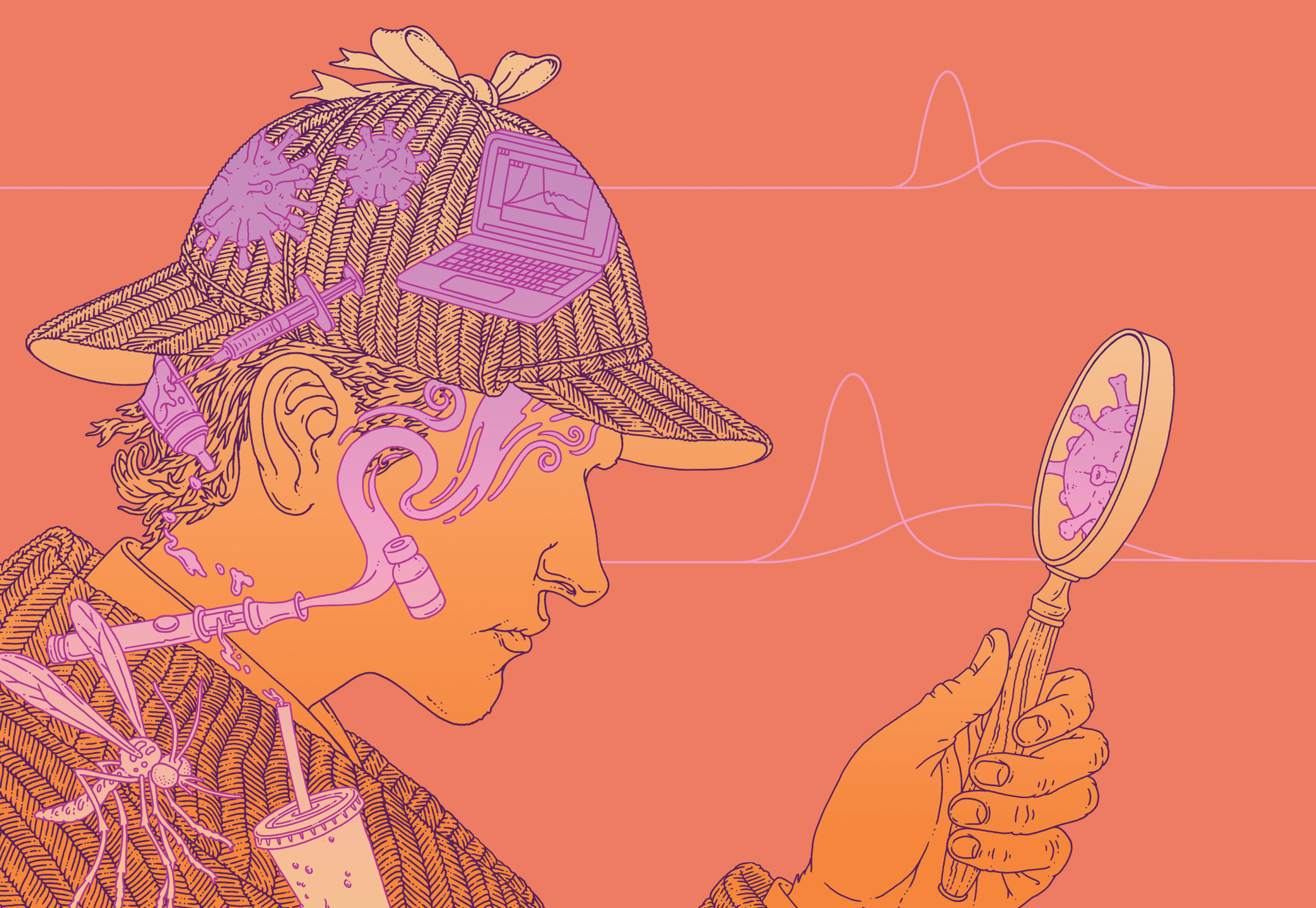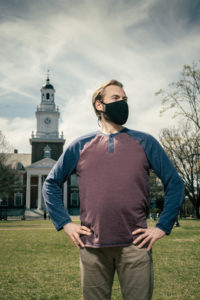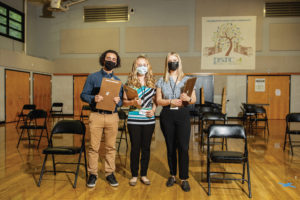Trending: public health
A profession gains prominence in a pandemic.

When it comes to the pandemic response, our disease detectives take the case and the spotlight.
Prior to 2020, Carolina Borges had grown perfectly used to people being unfamiliar with her field. “Epi-what?” new friends would say when she would tell them she taught epidemiology — the systematic, scientific study of diseases — at The College of New Jersey. But since COVID-19 was declared a pandemic, she’s noticed a big change.
“Recently I told an Uber driver, ‘I teach epidemiology,’ and his response was ‘Oh, that’s so cool. What do you think about this? What do you think about that?’ He knew what I was talking about,” says Borges. “Two years ago, that would never have happened. Now, the pandemic is showing these professionals working behind the scenes.”

Public health, including the work of epidemiologists like Borges, has long been a below-deck operation, bringing together data and practice to address health risks, threats, and inequities on a communal and societal scale — from plans for vaccine distribution to bans on sugary drinks to awareness campaigns about the danger of vaping. But during the novel coronavirus pandemic of 2020, public health burst onto the forefront of broader awareness: Lockdown orders and mask mandates affected homes, schools, and businesses alike; jargon like flattening the curve went mainstream; and Anthony Fauci, director of the National Institute of Allergy and Infectious Diseases, became a household name, headlining the nightly news.
Not only is public health now more visible, Borges says, the profession, often confused with medical care, is becoming better understood. “Clinical care is important: People will keep getting diseases and will need treatment,” she says. “But we need planning, prevention, and management too. Public health professionals do a lot of disease detective work.”
Marc Trotochaud ’16, an analyst at Johns Hopkins’ Center for Health Security and a research associate at the Bloomberg School of Public Health, looks at the profession on a global scale.
“It’s so many different things,” he says of his field. “It’s people who work in health care, sanitation, food inspection, health communications, and disease prevention. One might have a background in social and behavioral science, like I do, or some might have a chemistry background.”

Trotochaud has drawn on his research at the intersection of behavior and communications to inform public health policy and guide the distribution of information during the pandemic. He has seen the Twitter account for the Center for Health Security grow in the past year from a few hundred followers to more than 200,000. “When there is an outbreak, suddenly people are much more interested,” Trotochaud says. “That’s the shift that’s happening right now.”
At TCNJ’s School of Nursing, Health, and Exercise Science, faculty and students were already well aware of public health at work in the world around them; but as it has broken out into the spotlight, they’ve found themselves in instrumental roles on the front lines against COVID-19, assisting with testing, contact tracing, quarantine and isolation support, and health-related communication campaigns.
Leading up to this moment, the college’s public health department had already been growing fast. Established in 2014, it was expanded to include a master’s program in 2018. Public Health Chair Brenda Seals found her way into the field through her work with survivors of sexual assault during another American epidemic, HIV. That led to a post at the Centers for Disease Control and Prevention, and later, to teaching. Students who may have considered studying medicine are drawn to public health for the same reasons she first was.
“Instead of working one on one with clients,” she says, “we’re working more at a population level, and that’s a really powerful feeling.”
Ethan Moss ’24 is one of the department’s students who became enamored with making “changes at a systemic level,” he says. “My ultimate career goal is to be a medical director of a city hospital system.”
As an intern at the Princeton Health Department over the past year, Moss supported the launch of COVID-19 testing clinics, determining optimal clinic locations, writing best practices for safety, and building appointment scheduling systems and a sign-up workflow for clinic volunteers. Moss also built the online vaccine appointment scheduling system the city of Princeton uses, which he designed to be not only user friendly but also to generate and parse data used by the New Jersey Department of Health for the state’s immunization database, expanding public health officials’ ability to monitor and investigate disease behavior.
Jeffery Grosser, health officer at the Princeton Health Department, says his team is small, but they cover a lot of ground. “Much of what we do is very dependent on the environment around us,” he says. “Sometimes we have to drop everything to respond to something else that’s happening.” This year has been full of “drop everything” moments. But along with TCNJ faculty, including Borges, who has worked with his department as an advising epidemiologist, TCNJ students have taken the initiative, proving a major advantage in the town’s pandemic response.

Alongside Moss, Jessica Fleischman ’20, MPH ’21 also plays an integral role on the Princeton Health Department team. She says her responsibilities evolve on a daily basis, responding to the department’s most immediate needs: working as a contact tracer; helping to develop clinical documents, consent forms, and screening tools; and providing operational support to the clinics, all on top of the department’s ongoing non-COVID-related projects.
The work has been tireless, she says, for staff and interns alike. The team has kept a core focus on ensuring that the distribution of the department’s allotment of COVID-19 vaccines is not only efficient but equitable.
“Working at Princeton Health Department has taught me that when a challenge arises, you meet it with a solution,” Fleischman says.
With components focused on gathering data, monitoring and tracking disease spread and behavior, and disseminating information to help prevent, manage, and mitigate outbreaks, the public health system is an integrated one with a lot of moving parts. While the field has already drawn valuable new attention, support, and resources this year, stakeholders agree that there is a great deal of work ahead.
“Local public health departments are traditionally underfunded and understaffed,” says Trotochaud. While more funding for academic research always helps, he says, “building these systems on the ground and developing relationships to make the response more efficient” is one of the most dire needs he sees moving forward.
When it comes to fighting future pandemics — or even variants of this one — Fleischman says her experience at Princeton Health Department has clarified the need for improved response times to positive cases and exposures to viruses like COVID-19.
She adds that vaccine hesitancy and resistance to public health measures remain obstacles to fighting the pandemic locally and nationwide; knowledge-boosting information campaigns will continue to be key. Last, but not least, the field should increasingly strive for equity, she says, “turning the focus to vulnerable populations to improve outreach initiatives and address potential gaps in health services offered to these communities.”
Likewise, Borges, Seals, and Trotochaud are all searching for opportunities to address inequity in their field in order to improve public health overall.
“One of the biggest challenges we face in public health is that our society promotes this idea that to achieve what you want in life, it’s just a matter of wanting,” Borges says. “I’m not so sure about that.”
In communities where health issues like drug use and obesity are high, Borges says it is important to look at the context of those conditions rather than assuming they result from individual choices. “It’s really easy to blame and point our fingers, but if someone comes from a context where they don’t have their basic needs met, we can’t talk about autonomy in that case,” she says. “If you’re in a place where you’re dealing with crime, violence, poverty, we cannot neglect the impact that has on a person.”
Borges believes health approaches that go beyond individual care to address equity at a systemic level will mean more people with better individual health, more people in the workforce, more children growing up with the resources to develop their full potential, and ultimately, healthier communities. “It’s like a snowball effect,” she says of this top-down approach.
According to Borges, one thing that can push this trend forward in the future is prepared leaders. In this regard, the pandemic may prove to have a silver lining: the newfound visibility of the field is generating new interest from students who may not have otherwise chosen it as a career track. These students are public health’s next generation of leadership.
“The interest in public health is growing now, but still, we have a shortage in our workforce,” Borges says. “We need new voices in our discussions; we need people to enhance the way we communicate in a lay language that the public can understand; we need trained people, with this mindset and professionalism, to come join our table.”
These are gaps she hopes today’s public health students will fill — and after experiencing the pandemic, they’ve already learned a fundamental lesson that Borges shares with her classes constantly: “Public health is about listening to what’s happening out there,” she says, “and discovering how we can fight, prevent, and solve that problem.”
Illustration: Eric Nyquist
Photos: Bill Cardoni and Mike Morgan
Posted on May 24, 2021

